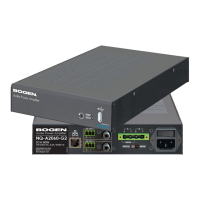17
Setting DSP Parameters
When you select DSP (Digital Signal Processing) from the appliance’s web UI, the DSP
page appears. This page presents a mixing board interface, allowing you to monitor, con-
trol, and perform various DSP operations on digital channels A and B.
Note: Digital Signal Processing (DSP) refers to the digital operations that are performed to
modify or control the digital signal.
The signal for a channel (A or B) can come from either of two sources:
1 An analog line input signal
2 A digital VoIP audio stream or multicast audio
The level of an analog line input signal can be adjusted via the router’s Analog Input Gain
c
o
ntrol (see "Router” on page 43), after which the analog signal is converted to a digital
signal. The digital signal can then be routed to one or more of the mixer’s two output
c
h
annels (A and B) via the DSP Router, where it can be conditioned using the mixing
board interface.
Digital VoIP audio streams received over the network—whether as SIP-initiated phone
ca
lls or as multicast audio (see SIP and Multicast configuration settings in "Configuration
Settings Tab Parameters” on page 9)—are also controlled by the mixer’s output channels
(A and B).
kern.log Contains information logged by the kernel and recent
l
o
gin information for all users.
lastlog Contains information on the last login of each user.
messages Contains messages generated by Nyquist.
php5-fpm.log Contains errors generated by the PHP script.
syslog Contains list of errors that occur when the server is run-
ning and server start and stop records
user.log Contains information about all user level logs.
wtmp Contains historical record of users logins at which ter-
minals, logouts, system events, and current status of
t
h
e system, and system boot time.
Table 7, Logs (Continued)
Log Description

